
Customers can stay safe during winter months by following helpful gas safety tips
OAKLAND, Calif., Nov. 5, 2025 /PRNewswire/ -- To help customers prepare their gas appliances for safe use during the cold weather months ahead, Pacific Gas and Electric Company (PG&E) is offering free in-home gas safety checks. During the gas safety checks, PG&E also will re-light pilot lights for customers who have heaters or other appliances that have been turned off during warmer months.
Free safety checks help ensure that gas appliances, including water heaters, furnaces and ovens, are operating safely and efficiently, reducing the risk of carbon monoxide (CO) poisoning within the home. Carbon monoxide is especially dangerous because it can't be seen, smelled or heard.
According to the Centers for Disease Control and Prevention, each year more than 400 Americans die from unintentional CO poisoning not linked to fires, more than 100,000 visit the emergency room, and more than 14,000 are hospitalized. Since the start of 2025, PG&E has responded to more than 6,000 incidents where the presence of carbon monoxide is suspected.
"This complimentary safety program is a great way for customers to prepare for increased use of their natural gas appliances this winter. A team member will inspect all gas appliances to ensure proper functionality and perform pilot re-lights. Scheduling a free gas safety check is a benefit PG&E proudly provides our customers to ensure their safety and comfort," said Jeff Janvier, PG&E Gas Operations Lead.
Before the colder winter months when natural gas appliances typically see the most use, PG&E encourages customers to schedule an inspection by visiting www.pge.com/pilotlights. Scheduling your appointment online is free and easy and will help you avoid hold times on our customer service line. Customers can also call 800-743-5000 to schedule appointments.
Helpful Winter Gas Safety Tips
- Install carbon monoxide detectors to warn when concentration levels are high.
- All California single-family homes are required to have carbon monoxide detectors.
- Carbon monoxide detectors should be installed on every floor, near sleeping areas and common areas.
- These devices should be tested twice a year, and batteries replaced if necessary.
- Check the expiration date – most carbon monoxide detectors have a shelf life of five to seven years.
- Consider installing methane detectors in enclosed spaces where gas appliances are being operated as an additional line of protection. Click here to learn more.
- Never use products inside the home that generate dangerous levels of carbon monoxide, such as generators, outdoor grills, or propane heaters.
- Never use cooking devices such as ovens or stoves for home heating purposes.
- When using the fireplace to stay warm, make sure the flue is open so venting can occur safely through the chimney.
- Make sure water heaters and other natural gas appliances have proper ventilation.
- Click here for more winter heating safety and savings tips.
If you suspect carbon monoxide in your home, you should get out immediately and call 911. If a PG&E customer ever smells the distinctive "rotten egg" odor of natural gas in or around their home or business they should immediately evacuate and then call 911 and PG&E at 1-800-743-5000.
About PG&E
Pacific Gas and Electric Company, a subsidiary of PG&E Corporation (NYSE: PCG), is a combined natural gas and electric utility serving more than 16 million people across 70,000 square miles in Northern and Central California. For more information, visit pge.com and pge.com/news.
SOURCE Pacific Gas and Electric Company








Share this article